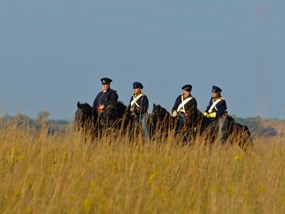
FOSC VIP Michelle Martin Throughout United States history, especially during the nineteenth century, mounted troops served as the advance guard of the United States Army. They helped to strengthen security in times of peace and served as protectors and watchdogs in times of war. In the mid-nineteenth century just prior to the Civil War, three different types of mounted troops existed simultaneously in the United States Army: cavalry, dragoons, and mounted riflemen. While all traveled on horseback, theoretically, there were enough distinctions between the various units to merit them being called by different names. Heavy vs. Light CavalryDuring medieval times, two distinctions of cavalry had emerged: heavy and light cavalry. Heavy cavalry referred to those soldiers who were heavily armored and used as shock troops, charging their enemies with lances. Knights often charged in close formation, similar to the shoulder to shoulder tactics of infantry charges in nineteenth century American armies. The sight of a line of heavily armored knights charging at full gallop had a profound psychological impact on the enemy. Light cavalry carried less armour and were more of a reconnaissance force, used for scouting, screening and skirmishing. By the 1700s, heavy cavalry still played a role as shock troops, and light cavalry were still used as reconnaissance, but a new type of unit, dragoons, regarded as a medium cavalry, had emerged. Whereas cavalry did most of their fighting on horse, dragoons rode into battle and then did most of their fighting dismounted; although, they were actually trained to fight both ways. The term "dragoon" came from the nickname for their weapon, the carbine or short musket, called "the dragon," which referred to the fire that emits out of the gun when fired, hence the term "dragon" or dragoon soldiers. Mounted Forces in the United StatesIn the United States, there were four regiments of light dragoons and other mounted forces that fought in the Revolutionary War. Dragoons also fought in the War of 1812, but by 1815, all of the mounted forces had been disbanded. A battalion of mounted rangers was organized in 1832, but it was soon disbanded and a dragoon regiment was organized in its place. In 1833, when the first regiment of dragoons was organized, there were no other mounted forces in the United States Army. In fact, heavy cavalry never existed in the United States Army in the nineteenth century. Dragoons may have been treated like second-class cavalry in the European armies, but not in the United States. As mentioned above, when the dragoons were organized 1833, they were the only mounted troops in the United States. They were considered an elite fighting force trained to fight both on horseback and on foot. The First Dragoon Regiment was composed of ten companies, but after the first five companies were recruited, they were sent to Fort Gibson under their Colonel, Henry Dodge, to winter. The others followed later. The American Army in 1844 consisted of 8573 men; the ten companies of the First Dragoons numbered about 623 men. Each company at full strength had a captain, a first lieutenant, a second lieutenant, four sergeants, four corporals, two buglers, one farrier and blacksmith, and fifty privates. The men were armed with Hall's carbines and, later, musketoons, dragoon sabers called "old wristbreakers" of the Prussian pattern, and horse pistols. All of the weapons had drawbacks. The carbine when carried muzzle down lost the charge from the chamber and could not stand much wear. In Indian fighting, the sabers were simply a nuisance. They jingled abominably, were difficult to keep sharp in metal scabbards, and when a soldier was "close enough on an Indian to use a saber," it was about even "as to which goes under first." Mounted RiflemenBesides dragoons, there were also mounted riflemen stationed at Fort Scott. The United States Army organized a regiment of mounted riflemen in 1845, for defense of forts along the Oregon Trail. This regiment fought in the Mexican War and then was later assigned to duties in the far West. Two companies of mounted riflemen were stationed at Fort Scott from 1852-53, but by that time Fort Scott was obsolete. The army abandoned Fort Scott in 1853. The difference between mounted riflemen and dragoons was in their weaponry. Dragoons were armed with carbines, sabers, and pistols. Mounted riflemen had no sabers and had, as the name implied, rifles. US Army Cavalry and the End of the DragoonThe US Army organized another mounted force, two cavalry regiments, in 1855. The cavalry of 1855 was different than the traditional cavalry of European troops; it was more of a reconnaissance or a screening force. The cavalry were supposed to be the eyes and ears of the army. Commanding generals relied on cavalry to know the enemy's troop strength and movements. One of the differences between the dragoons and the cavalry was the dragoons rode horses for mobility but for the most part they dismounted when they went into action, using their carbines or musketoons. However, they were armed with sabers and thus were trained to fight both mounted and dismounted. Cavalry did most of their fighting on horseback. By the late 1850s, the army had two regiments of dragoons, one regiment of mounted riflemen, and two regiments of light cavalry. To simplify matters, in 1861, all of the mounted regiments were redesignated or renamed cavalry, thereby ending the era of the dragoon. Information for this page was taken from the Historic Furnishing Plan for The Dragoon Stables by Sally Johnson Ketcham and from an article written by a staff member at Fort Scott National Historic Site. Experience more Life on the FrontierBack to Virtual Resource Center HomeDragoon Soldier PagesOverview | Program Outline | Tools of the Trade | Regulations | Historical Background | Recruitment | Training | Command Structure | Daily Life | Expeditions |
Last updated: May 23, 2022
